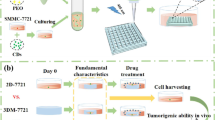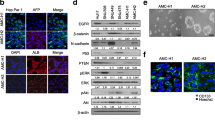Summary
Tyroserleutide (YSL), extracted from spleen of pigs, is a tripeptide that has shown therapeutic efficacy in an experimental BEL-7402 human hepatocarcinoma model. The hollow fiber assay (HFA) is a solid tumor model for large-scale screening of potential anticancer compounds that minimizes expenditures of materials, time, and money. Tumor cells are cultivated within biocompatible, semipermeable hollow fibers, which are implanted in immunosuppressed mice. In this study, the HFA was used to investigate the therapeutic efficacy of YSL for human hepatocarcinoma. In vitro effects of YSL on human hepatocarcinoma cell lines BEL-7402, SMMC-7721, Hep3B, HepG2, and SK-HEP-1 were assayed by the MTS method. In vivo effects of YSL on the five human hepatocarcinoma cell lines were assayed by HFA. Mice implanted with tumor cells in hollow fibers were treated with YSL, and the effects of YSL on tumor cell populations were assessed by MTT assay. YSL significantly inhibited the proliferation of the five human hepatocarcinoma, both in vitro and in vivo (P < 0.05). The HFA is a rapid, accurate, and economical method for evaluating the inhibitory effects of drugs on different tumor cells in vivo. These results support the clinical application of YSL for treatment of human hepatocarcinoma.


Similar content being viewed by others
References
Zhou HG, Gu GW (1998) New tendency in clinical pathology of primary liver cancer. Chinese Journal of Digestology 8:10–12
Yao Z, Lu R, Jia J, Zhao P, Yang J, Zheng M, Lu J, Jin M, Yang H, Gao W (2006) The effect of tripeptide tyroserleutide (YSL) on animal models of hepatocarcinoma. Peptides 27:1167–1172
Hollings head MG, Alley MC, Camalier RF, Abbott BJ, Mayo JG, Malspeis L, Grever MR (1995) In vivo cultivation of tumor cells in hollow fibers. Life Sci 57:131–141
Chen RM, Zhu DH, Ye XZ (1975) The establishments and characteristic of human hepatocarcinoma cells BEL-7402. Chin Sci Bull 2:434–436
Dong CR, Zhou RH, Lv DF (1980) The establishment and biological characteristic of human hepatocarcinoma cells SMMC-7721. Academic Journal of Second Military Medical University 1:5–9
Knowles BB, Aden DP (1983) Human hepatoma derived cell line, process for preparation thereof, and uses therefore. US Patent: 4393133, 1983-07-12
Knowles BB, Howe CC, Aden DP (1980) Human hepatocellular carcinoma cell lines secrete the major plasma proteins and hepatitis B surface antigen. Science 209:497–499
Heffelfinger SC, Hawkins HH, Barrish J, Taylor L, Darlington GJ (1992) SK HEP-1: a human cell line of endothelial origin. In Vitro Cell Dev Biol 28A:136–142
Buttke TM, McCubrey JA, Owen TC (1993) Use of an aqueous soluble tetrazolium/formazan assay to measure viability and proliferation of lymphokine-dependent cell lines. J Immunol Methods 157:233–240
Hall LA, Krauthauser CM, Wexler RS, Hollingshead MG, Slee AM, Kerr JS (2000) The hollow fiber assay: continued characterization with novel approaches. Anticancer Res 20:903–911
Driscoll JS (1984) The preclinical new drug research program of the National Cancer Institute. Cancer Treat Rep 68:63–76
Kolberg RJ (1990) Casting a wider net to catch cancer cures. J NIH Res 2:82–84
Suggitt M, Bibby MC (2005) 50 years of preclinical anticancer drug screening: empirical to target-driven approaches. Clin Cancer Res 11:971–981
Monga M, Sausville EA (2002) Developmental therapeutics program at the NCI: molecular target and drug discovery process. Leukemia 16:520–526
Gieni RS, Li Y, HayGlass KT (1995) Comparison of [3H]thymidine incorporation with MTT- and MTS-based bioassays for human and murine IL-2 and IL-4 analysis. Tetrazolium assays provide markedly enhanced sensitivity. J Immunol Methods 187:85–93
Everett R (1984) Factors affecting spontaneous tumor incidence rates in mice: a literature review. Crit Rev Toxicol 13:235–251
Levy JP, Leclerc JC (1977) The murine sarcoma virus-induced tumor: exception or general model in tumor immunology? Adv Cancer Res 24:1–66
Mattern J, Bak M, Hahn EW, Volm M (1988) Human tumor xenografts as model for drug testing. Cancer Metastasis Rev 7:263–284
Webster MA, Muller WJ (1994) Mammary tumorigenesis and metastasis in transgenic mice. Semin Cancer Biol 5:69–76
Hall LA, Krauthauser CM, Wexler RS, Slee AM, Kerr JS (2003) The hollow fiber assay. Methods Mol Med 74:545–566
Hassan SB, de la Torre M, Nygren P, Karlsson MO, Larsson R, Jonsson E (2001) A hollow fiber model for in vitro studies of cytotoxic compounds: activity of the cyanoguanidine CHS 828. Anticancer Drugs 12:33–42
Lu R, Jia J, Bao L, Fu Z, Li G, Wang S, Wang Z, Jin M, Gao W, Yao Z (2006) Experimental study of the inhibition of human hepatocarcinoma Bel7402 cells by the tripeptide tyroserleutide(YSL). Cancer Chemother Pharmacol 57:248–256
Xie TP, Gu XB, Zhu HL, Ji HG (2005) High-throughput screening approaches for anticancer drugs in vivo—Hollow fiber assay. Chinese Pharmaceutical Journal 40:469–470
Acknowledgments
This work was supported by Grants for the National High Technology Research and Development Program of China (“863” Program, China) (2004AA2Z3170, 2005AA2Z3D40) and the National Basic Research Program (973 Program, China) and by an important project grant (03007) from the Department of Education of China.
Author information
Authors and Affiliations
Corresponding author
Additional information
Xiao-lei Li and Jun-yan Liu contributed equally to this paper.
Rights and permissions
About this article
Cite this article
Li, Xl., Liu, Jy., Lu, R. et al. Evaluation of the therapeutic efficacy of tripeptide tyroserleutide (YSL) for human hepatocarcinoma by in vivo hollow fiber assay. Invest New Drugs 26, 525–529 (2008). https://doi.org/10.1007/s10637-008-9121-8
Received:
Accepted:
Published:
Issue Date:
DOI: https://doi.org/10.1007/s10637-008-9121-8




